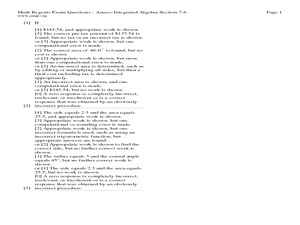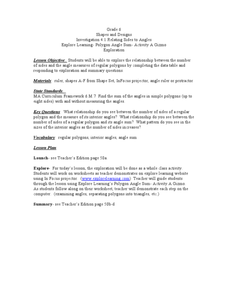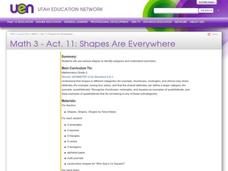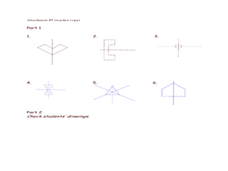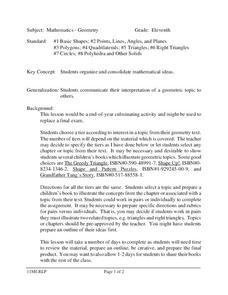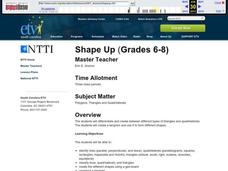Curated OER
Area of Irregular Polygons
In this geometry worksheet, 10th graders determine the area of irregular polygons. The one page worksheet contains three problems. Solutions are provided.
Pennsylvania Department of Education
A Geometric Scavenger Hunt
Fifth graders connect their knowledge of polygons and polyhedrons. In this geometric shapes instructional activity, 5th graders identify and classify two- and three-dimensional objects. Students construct a polyhedron out of polygons and...
Curated OER
Edible Geometry
Middle schoolers examine a chart that lists the main characteristics of polygons and 3 dimensional figures. They make examples of the polygons and figures using pretzels and gum drops showing how the gum drops are vertices and the...
Curated OER
Geometric Shapes
Young scholars identify polygons. In this geometric shape lesson, students explore the characteristics of polygons. They identify polygons, and classify triangles according to their sides and angles. Young scholars...
Curated OER
They're Everywhere! They're Everywhere!
Learners gain an appreciation of the polygons and polyhedrons around them that make their world one of order and strength. They build polygons and polyhedrons, and then construct airplanes out of polygons.
Curated OER
Shapes and Designs
In this shapes and designs worksheet, 10th graders solve and complete 6 different types of problems. First, they fill in the first two columns of the table show with their shapes. Then, students measure the interior angles of each...
Curated OER
Similarity
Students find the factor of proportionality in similar polygons. In this similarity of polygons lesson plan, students measure the sides and angles of polygons and derive a factor of proportionality between corresponding pairs of sides...
Curated OER
Sum of Interior Angles
In this sum of interior angles learning exercise, 10th graders solve 10 different problems that are related to determining the sum of various interior angles in figures. First, they determine the sum of the interior angles of a...
Curated OER
Exploring Tessellations
Fifth graders examine how to make tessellations. In this tessellation lesson, 5th graders review the meaning of the word "polygon" while the teacher shows them various examples. They practice making tiling patterns or tessellation's with...
Curated OER
Shapes Are Everywhere
Third graders use various shapes to identify polygons and understand symmetry. They explore pattern blocks noticing their similarities and differences, then share with other team members. They draw 3 polygons in their journals and...
Curated OER
Using R&R to Teach Mathematics
Second graders create a shape garden. In this polygons lesson, 2nd graders practice making shapes using a geoboard and read the book The Greedy Triangle by Marilyn Burns. Students also design a shape garden using construction...
Curated OER
Where has Polly Gone?
Learners explore polygons and their uses in careers. They also discover polygons shapes in manmade objects and nature. They use their acquired knowledge to construct a strong structure using polygon shapes.
Curated OER
Angle Bisectors
In this angle bisector worksheet, 10th graders solve and complete 23 various types of geometry problems. First, they find the angles listed in the figure shown. Then, students determine the sum of the interior angles of a polygon. They...
Curated OER
Similar Polygons
In this similar polygons activity, students identify the corresponding sides of polygons. They use proportions to solve problems. Students determine the scale factor of similar figures. This two-page activity contains...
Curated OER
Tessellmaniacs
Seventh graders create 3 original tessellation using polygons. They slide, turn, rotate and glide their designs on the computer. They print their tessellation on a T-shirt and teach the 6th graders about tessellations.
Curated OER
Grade 3: What Can I Make with 30 Centimeters?
Third graders create polygons with perimeters of 30 centimeters, use the centimeter grid paper to determine the area of each shape, and organize the shapes to make generalizations from the patterns they see.
Curated OER
Obtuse Angles
Third graders recognize and identify geometric shapes, work with manipulatives to reinforce understanding, and create polygons with various angles to display their knowledge of the different types of angles.
Curated OER
Similar Polygons
In this similar polygons activity, 10th graders solve and complete 20 various types of problems. First, they solve each proportion. Then, students write a ratio expressing the slope of a line through each pair of points. In addition,...
Curated OER
Symmetry and Tangrams
Sixth graders build figures out of tangrams. In this symmetry instructional activity, 6th graders view tangrams and identify the polygons included in them. Students divide into groups, identify their tangram pieces, define the lines of...
Curated OER
Napolean Triangle
Students investigate the Napoleon triangle theory. In this polygon lesson, students differentiate between the boundary points, interior and lattice point of a polygon. They apply concepts of equilateral triangles to solve...
Curated OER
Exploring Area and Perimeter
Two students are blindfolded and each receives a cardboard square, one with pompoms glued around the edge and one with pompoms glued all over the surface. They identify what they feel. The class discusses perimeter and area of polygons....
Curated OER
Basic Shapes
Students create books about shapes. In this shape lesson plan, students select a topic such as points, lines, angles, planes, polygons, quadrilaterals, triangles, circles, and polyhedra. In groups, they create an illustrated...
Curated OER
Shape Up
Students explore differents types of triangles and quadriaterals. In this polygon lesson, students model identify and compare two and three dimensional geometric figures. Students create tangrams and discover the difference between...
Curated OER
Properties of Quadrilaterals
In this properties of quadrilaterals worksheet, students use the properties of quadrilaterals to find the perimeter, angle measurement or length of a missing side of a given polygon. Examples and explanations of the properties are...
